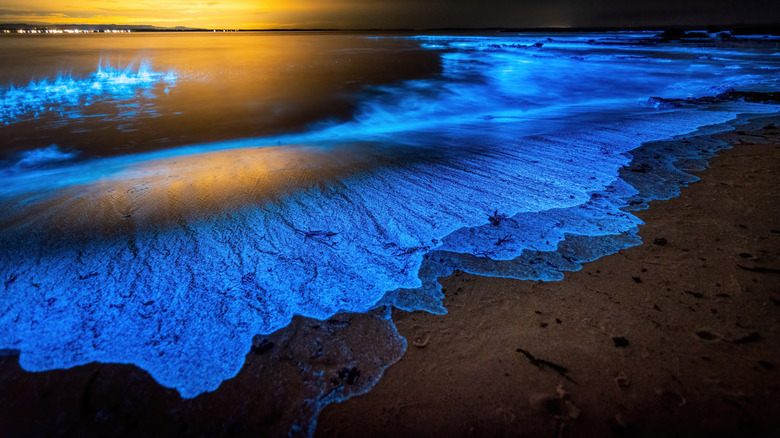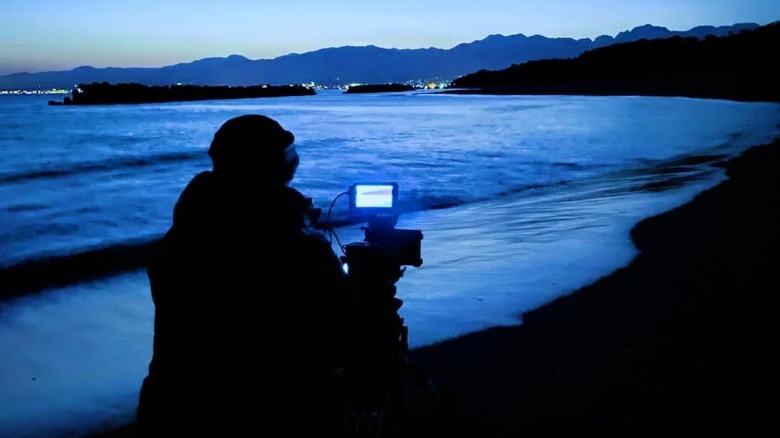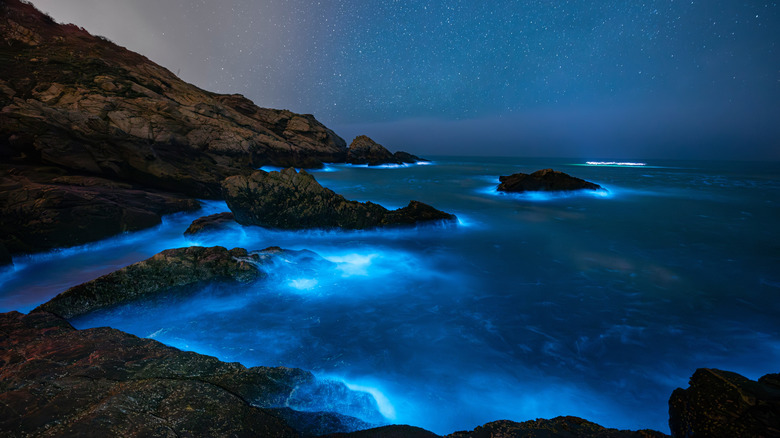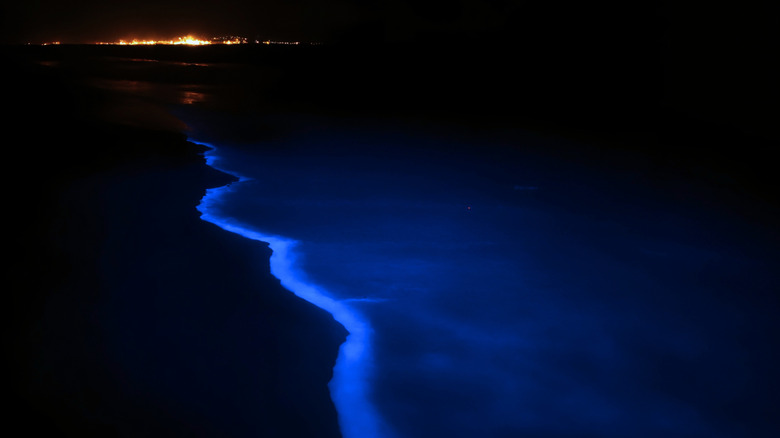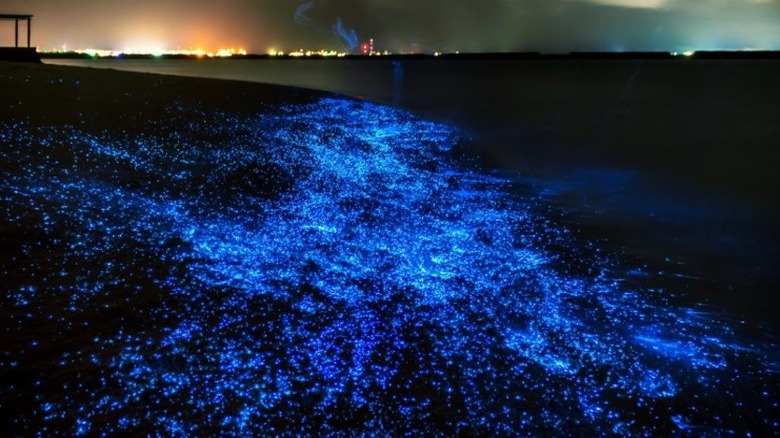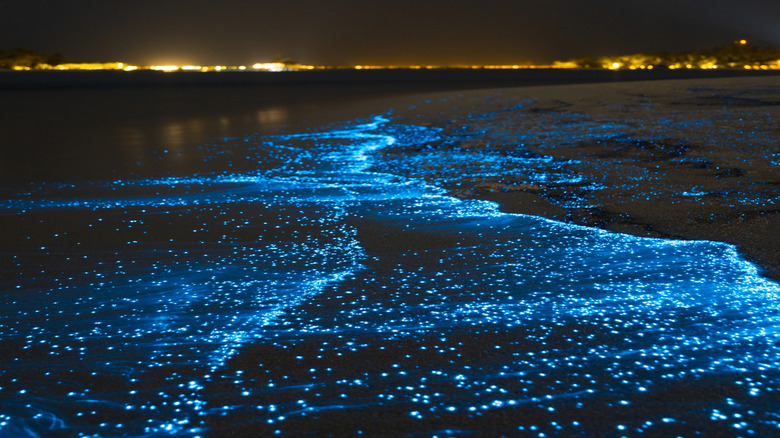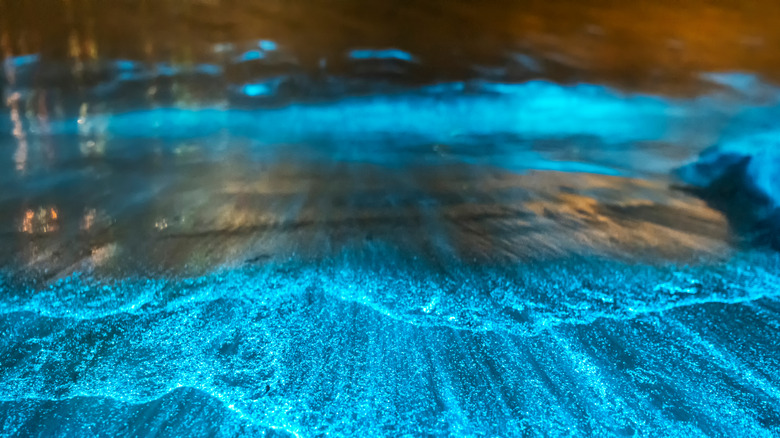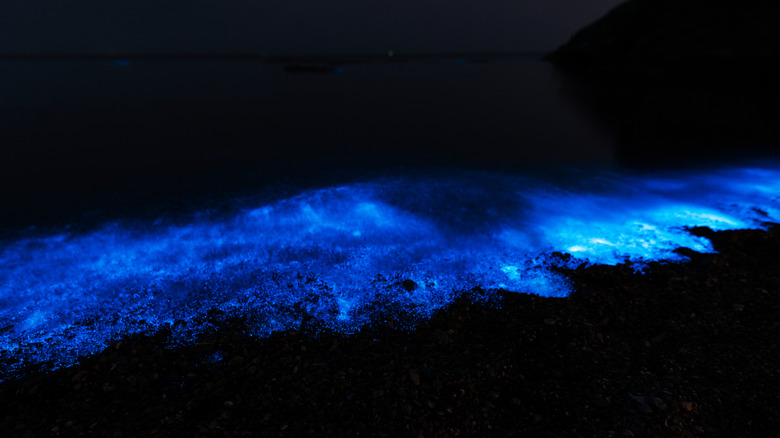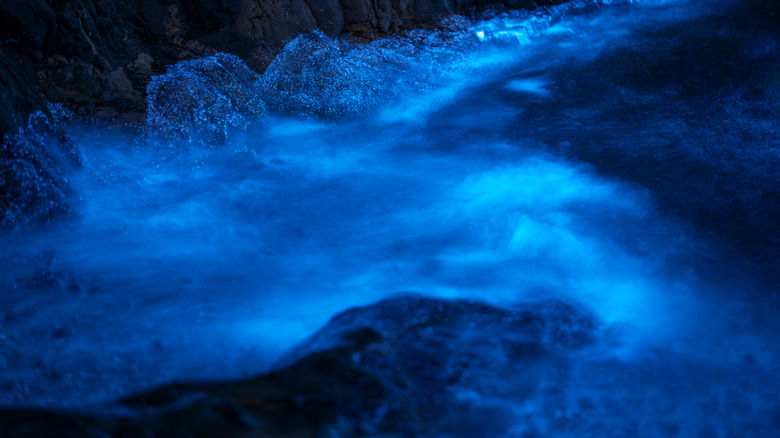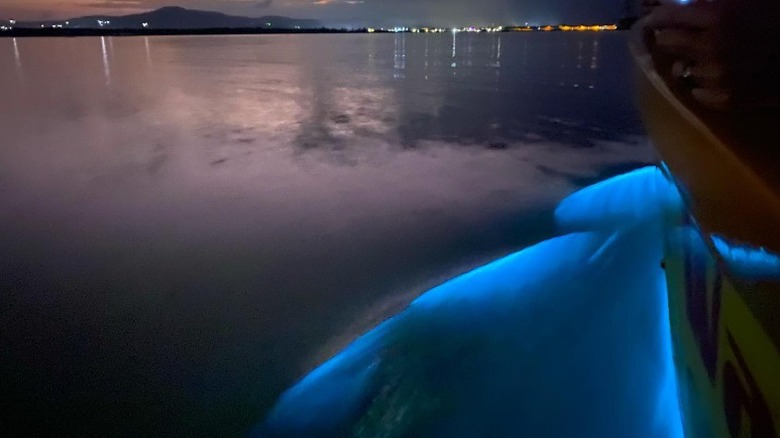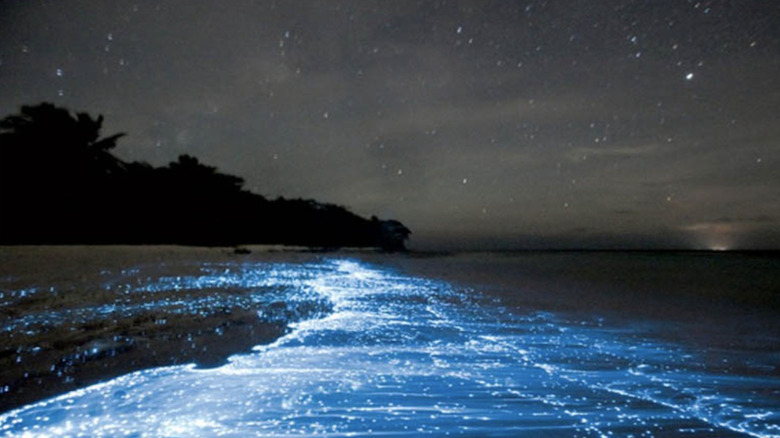The Most Beautiful Destinations Around The World To Experience Bioluminescence
If you touched something and it suddenly glowed electric blue, you'd feel like you had somehow attained superpowers. If you walked upon a shore to suddenly see thousands of twinkling stars on the sand, you'd think you'd stumbled upon an enchanted fairy bower or the glowing forest from "Avatar." All across the world, microscopic, single-celled critters called dinoflagellates, or Noctiluca scintillans (Latin for "sparkling night light") emit an enchanted beam of light anytime they're disturbed. When millions are disturbed at once, the result is a cascade of enchanted light and enchanted humans who feel as though they've entered another realm.
We searched all over the planet for places that will make you feel like you've been spirited away into another one. Most bioluminescent beaches are located in the tropics, where warm waters provide the nutrients dinoflagellates — or a number of other organisms like squid or even sharks — need to thrive. But the truth is they're everywhere, and you never know when sparks will fly from your finger into the water on a dark summer night. Without further ado, here are some beaches full of millions of glittering sapphires, beaches where you can conduct your own personal orchestra of light.
Toyama Bay, Japan
Most bioluminescence is caused when bioluminescent algae are disturbed by waves or ships, resulting in a chemical reaction that produces light. However, bioluminescent reactions can also occur in jellyfish, lobsters, fish, and even sharks. Toyama Bay, located in the central region of Japan's western coast, has become world-famous due to its illuminated squids, which turn the bay electric blue for a few months of the year.
Every year from March to June, a V-shaped current pushes tens of thousands of firefly squid to a roughly 9-mile stretch of Toyama Bay, and each night, boats of fishermen come to collect them. The squids caught in the nets emit a mesmerizing blue that illuminates the pitch-black sea. This twinkling light show has become a popular tourist attraction, even resulting in an entire museum. The best way to view the shimmering squids is to visit in April or May and book a tour run by the Hotaruika Museum, after the Japanese name for the squid. One to two-hour tours leave every night from the fishing port in Namerikawa and take visitors to the glowing fishing boats. Because the tours are so limited, they book up early and can sometimes be canceled that very night due to rough sea conditions. Book early and stay a few nights in case it doesn't work out. Be sure to also bring warm, waterproof clothing.
If the tour doesn't work out, you can still visit the Hotaruika Museum's Firefly Luminous Live Light Show, which simulates the experience. You can also head into town and taste the cooked squid, one of the few examples on this list where visitors can actually eat the glow — deep-fried, no less.
Matsu Islands, Taiwan
Normally, blue tears would be a sign of sadness. But in a lush archipelago just off the coast of mainland China, they're blue tears of joy. The residents of the Matsu Islands refer to the local bioluminescent phenomenon as the Blue Tears. Every year, from late April to October, thousands of tourists head to the islands to catch a glimpse of this neon cry.
Perhaps appropriately, the tears are caused by the agitation. As noted, when the Noctiluca scintillans become disturbed by waves or water motion, they glow bright blue, a response meant to ward off predators. For the best shot at a sighting, be sure you go on a dark, moonless night and bring a stick to move through the water and rile up the Sparkling Night Lights. On the popular Beihai Tunnel tour, visitors take a boat through a former military tunnel and are given paddles to put in the water to ensure the dinoflagellates are suitably annoyed.
If you'd like to catch the tears in the open ocean, take a Blue Tears boat ride, which departs nightly from the Qiaozi port in Beigan to Daqiu. Sightings aren't guaranteed, but if you travel around for a while on a dark night, chances are you'll catch at least one electrifying glimpse of electric blue. One traveler noted that they saw many beachgoers jumping into the water at Daqiu, trying to rile up the plankton. If you don't catch anything, the Matsu Islands also have a museum that simulates the experience. At the Matsu Blue Tears Ecological Museum in Nangan, algae are placed in bowls, and visitors can create the bioluminescent effect using plastic pipettes.
Ha Long Bay, Vietnam
Quite often, bioluminescence is a beach's main attraction. But when thousands of glowing underwater stars are written about like a secondary bonus, you know you're somewhere truly magnificent. Ha Long Bay, a collection of nearly 2,000 towering limestone karsts and islets in a bay in northeastern Vietnam, is a UNESCO World Heritage Site and one of the New Seven Wonders of Nature. These karsts have rainforests growing on top of them, caves inside of them, and are surrounded on all sides by calm, tropical water. In the dead of night, that water can sometimes glow with the twinkling lights of the dinoflagellates, elevating this already stunning bay into the realm of the divine.
Unfortunately, we have bad news and good news. Due to the possibility of divine revelation, Ha Long Bay is one of the most popular sites in Vietnam and Southeast Asia. It is full of cruises and luxury yachts, many of which stay in the bay for several nights. So, while catching bioluminescence at this site promises heavenly transcendence, the lights of the many boats mean it is not often dark enough to see anything. Now for the good news: many cruise companies also run tours to nearby Lan Ha Bay and Cat Bo Island, which offer much of the beauty of Ha Long Bay with just a fraction of the crowds. Visitors can kayak their way through 300 limestone karsts, marveling every time the kayak paddle vibrates with electric blue.
Koh Rong, Cambodia
Like Ha Long Bay, Kah Rong is an idyllic paradise where glowing water is just one of many attractions. Travelers swoon over the island's nearly 30 miles of pristine turquoise beaches, where they can swim, kayak, paddleboard, or snorkel amidst the coral reefs.
At night, the water can remain just as turquoise as it is in the day, if you're lucky. Koh Rong's many beaches are renowned for their bioluminescent plankton, which adds mesmerizing streaks of blue to other black waters. However, while blue is the most common color, the plankton can also produce glowing red, orange, and green, adding another element of thrilling unpredictability. Several tours take visitors to the best bioluminescent beaches, which include Coconut Beach, Sunset Beach, and Lazy Beach. Sometimes, in the quietest parts of the beaches on dark, moonless nights, dozens of electric blue waves crash against the shore, making the ocean look like someone turned on some fabulous light switch underneath.
Some prefer to kayak along the quiet bays and create trails of neon blue with each paddle stroke. Other travelers grabbed their snorkeling masks and dove underwater, where she reported seeing a "glittering sparkle tornado" and a "surreal underwater light show." A quick word of caution about that glittering sparkle tornado: it can bite. Coming into contact with the plankton can cause rashes and itching that is harmless but uncomfortable. We'd advise staying in the kayak or on the shore, hard as it may be to pass up a surreal underwater light show.
Vaadhoo Island, Maldives
One of the best parts about traveling around the globe in search of bioluminescence is learning all the different phrases it's inspired. In Taiwan, they call it the "Blue Tears." In New Zealand, the "Aurora of the Sea." And in the Maldives, that sultry, sensory feast where everything has a dash of the sublime, it's the "Sea of Stars."
In the summer months, a quiet beach on Vaadhoo Island — a tiny resort island toward the northern edge of the Maldives — becomes exactly that. An entire galaxy's worth of glowing blue stars dot the water and the sand, resembling a mix between a beach, a fairy bower, and the most pristine of night skies. When you stick your hand in the water, it will glow. When you step onto the sand, it will also glow. Everything you touch, it seems, is magic.
If you're staying in one of Vaadhoo's many resorts from roughly June to October, you can just step outside during a moonless night to enjoy both the Sea of Stars below you and the actual stars above you. Still, some tour companies offer unique experiences, like yacht charters, or tours from dhonis, the traditional wooden Maldivian fishing boat famous for their artfully curved bows. While the Sea of Stars is the Maldives' best-known bioluminescent beach, the islands are actually teeming with different seas of stars. Talk to your tour company about the best ways to see the glowing beaches of Mudhdhoo, Hulhumalé, Mirihi, Kihaadhuffaru, Kuredu, Reethi, and Athuruga.
Jervis Bay, Australia
After the Sea of Stars, head down the Indian Ocean and along Australia's eastern coast for a chance at catching some "Sea Sparkles." Jervis Bay, a large bay about three hours south of Sydney surrounded by a pristine national park, is home to numerous beaches that are turquoise by day and sparkle turquoise at night.
For your best chance at catching the sparkle, visit in the warmer months from roughly December through April. Still, the plankton can be notoriously unpredictable: A bloom in July 2020 was reported to be one of the brightest on record. Whenever you visit, try a moonless or cloudy night and head to some of the beaches most renowned for sightings. These include Barfleur Beach, Hyams Beach, Plantation Point, Callala Bay, Blenheim Beach, and Scottish Rock Beach. If you're lucky, layers upon layers of entire waves will glow.
But even if the sparkle evades you, Jervis Bay is still full of effervescent magic. The area is renowned for its dolphins and whales, and visitors may even be lucky enough to spot dolphins, whales, and glowing plankton on a single cruise. And plankton aren't the only little creatures that glow here. At night, a World Heritage-listed trail through the bushland called the Grand Canyon Track glistens with thousands of glow worms, creating an enchanting forest of sparkling stars.
San Juan Islands, Washington
Bioluminescence is often associated with tropical beaches because the plankton thrives in sunlight and nutrient-rich warm waters. However, it is also present in colder places during the summer months, particularly in pristine waters like those surrounding the San Juan Islands in Washington state.
Heading diagonally across the Pacific, we arrive at a magical archipelago of over 172 named islands dotted across the Salish Sea, northwest of Seattle and just east of Victoria. The islands are a rugged paradise of forests, lakes, rivers, waterfalls, dolphins, whales, seals, and of most interest to us, dinoflagellates. Visit in July or August on a moonless night after a hot day and set out into one of the emblems of the Pacific Northwest: the kayak. Many tour companies offer kayaking tours of the best spots to view bioluminescence, like Westcott and Garrison bays and Deer Harbor. Some tour companies, like Discovery Sea Kayaks, only offer tours when there is little to no moon to ensure the best viewing possible.
The calm waters of the San Juans offer a still peacefulness that can be hard to find in the rougher oceans. They are also free of the dangerous red tides of warmer waters, which sometimes result in bioluminescence. That means that in these cool, clean waters, a single paddle stroke can result in a mesmerizing jolt of electric light. You may also see glowing jellyfish and shrimp, while you hear the bark of a seal, the chirp of a dolphin, or the thunderous crash of an orca whale.
Puerto Escondido, Mexico
Like the San Juan Islands, the magical lagoons near Puerto Escondido offer the chance to see bioluminescence in a calm, sheltered bay teeming with all forms of wildlife. The journey begins in Puerto Escondido, an artsy, historic, unpretentious, and under-the-radar village on the Oaxaca coast. Its beaches offer some of the best surfing in the world and the occasional flash of sea stars, but for some nighttime sparkle, book a tour and head to two nearby lagoons.
Laguna de Manialtepec, a coastal lagoon about 20 miles from the center of Puerto Escondido, shimmers a hypnotic blue, especially from July to December. Laguna de Chacahua glows all year round, though it takes two to three hours and a combination of cars and boats to get there. Once you do, you'll be richly rewarded with both year-round bioluminescence and lagoons teeming with mangrove forests, 246 species of flowers, and 189 species of animals. Since it's so far from town and there's so much in the area, we recommend staying overnight in either a tent, cabin, eco-lodge, or guesthouse.
During the day, several tours offer boat tours of the lagoon, allowing you to marvel at pelicans, herons, turtles, crocodiles, and much more. Some tours let you swim in the lagoon, even at night, when each stroke glows neon blue. However, due to the aforementioned crocodiles, double check your tour guide is certified before diving in.
Luminous Lagoon, Jamaica
The two Oaxacan lagoons are extraordinary, but there's only one Luminous Lagoon, and the name says it all. The glowing, mind-blowing lagoon in northern Jamaica is often cited as one of the world's largest and brightest displays of bioluminescence, drawing throngs of awed visitors and scientists each year.
The lagoon is located where the Martha Brae River meets the Caribbean Sea in the popular port of Falmouth. It was once the site of a wharf where large ships from valuable commodities like rum and sugar were transported between England and Jamaica. Now, its most valuable commodity is the millions of dinoflagellates thriving in the warm, shallow water, a mix of fresh and salt water, surrounded by beautiful mangroves.
Because the water is so uniquely suited for bioluminescence, visiting the Luminous Lagoon isn't a guessing game the way many of the other sites around the world are. That said, it's still best to visit during peak season from mid-December to mid-April when it's still plenty warm, but rain is less prevalent, and all the tours are open. And there are certainly plenty of tours. The most famous is the Glistening Waters Jamaica Luminous Lagoon Tour, a 45-minute tour through the lagoon led by a trained guide. Once in the lagoon, visitors can swim in the water, which is warm, filled with glowing fish, and only three to eight feet deep. Any stroke or splash glows, making swimmers feel as though they have magical powers. Other tours combine a trip to the lagoon with other local thrills like horseback riding on the waves, river tubing, and touring a haunted mansion. The Rose Hall Haunted Night Tour hits even harder once you've already seen the supernatural, ghostly glow of the Luminous Lagoon.
Mosquito Bay, Puerto Rico
We've quite literally saved the best for last. While Luminous Lagoon is a bioluminescent superstar, Mosquito Bay, on a small island off the coast of Puerto Rico, was recognized by the Guinness Book of World Records as the brightest bioluminescent bay in the world. Its extraordinary brightness is due to its unique geography as a small, warm, nutrient-rich S-shaped bay right at the mouth of the ocean. This is the perfect environment for dinoflagellates, and some estimates count up to 2.1 million of them in a single gallon of glowing water.
In order to keep its crown, Mosquito Bay is strict about its visitor policies. Visitors must come with a licensed tour agency. Swimming is not allowed due to concerns about sunscreens and other chemicals harming the dinoflagellates. For a similar reason, no boats are allowed except kayaks, some of which are clear-bottomed to allow for better views of the bioluminescence. And visitors will want to see as much of that as they can. On moonless nights year round, every single stroke of the kayak paddles glows bluer than anywhere else. Each movement is alive with hysterical color and life.
Like so many bioluminescent hotspots, the surrounding area is similarly impressive. The island boasts world-class beaches where you can swim, snorkel, dive, or ride horses. And if you'd like to swim with the dinoflagellates, Laguna Grande and La Parguera are two other Puerto Rico beaches that glow almost as bright.
